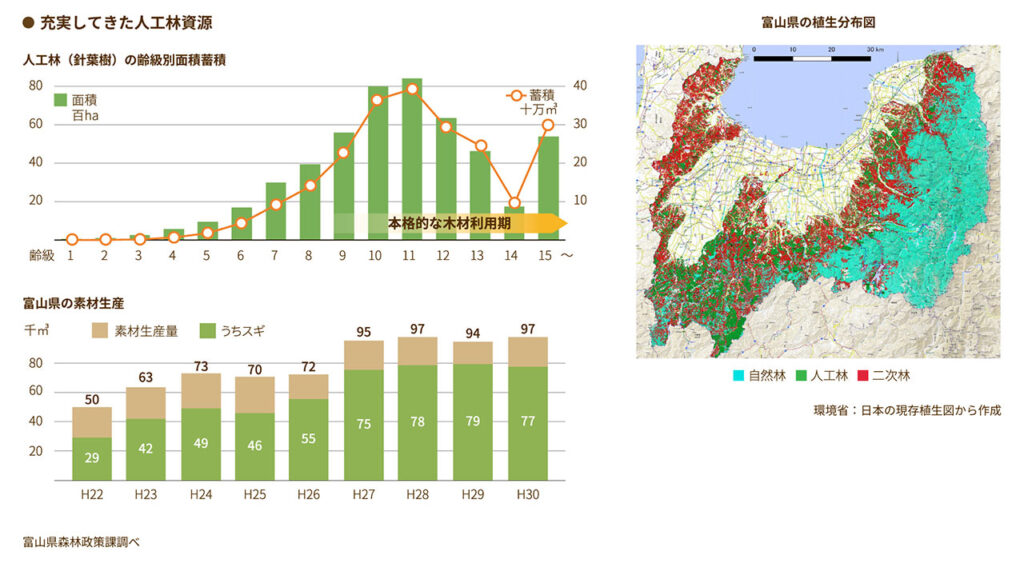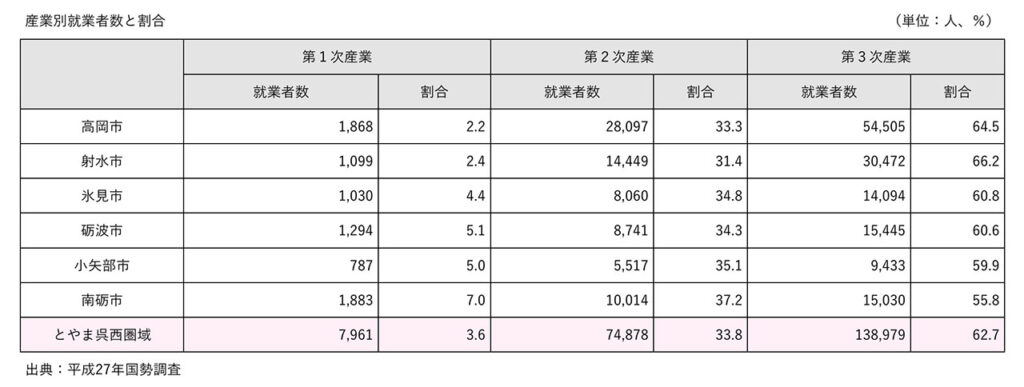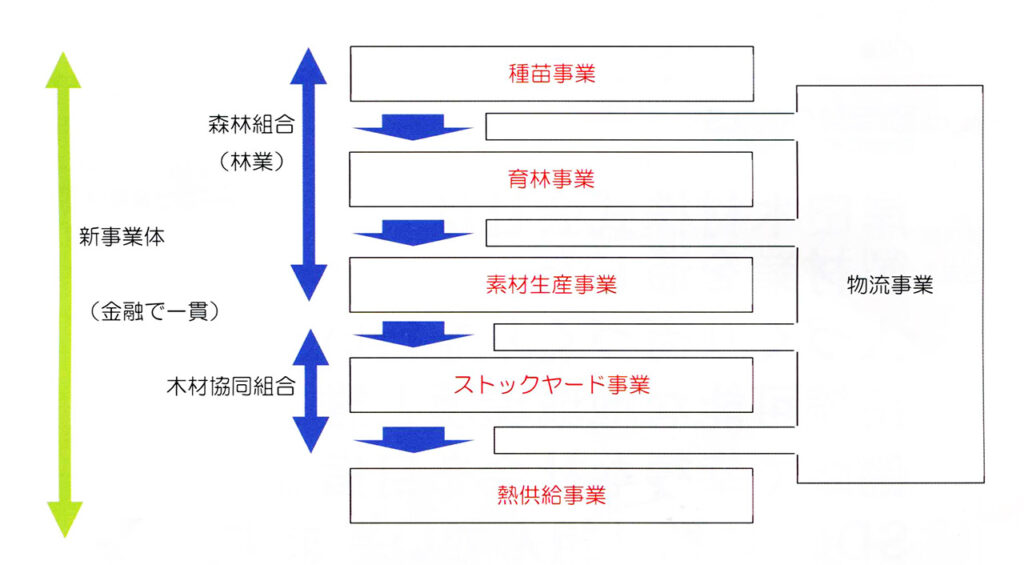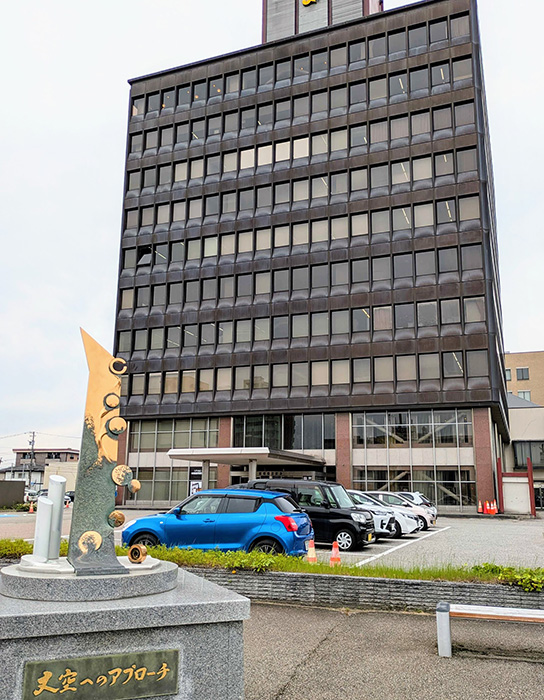Updated by "Forest Circular Economy" Editorial Board on July 14, 2025, 8:51 PM JST
Editorial Board, Forest Circular Economy
Forestcircularity-editor
We aim to realize "Vision 2050: Japan Shines, Forest Circular Economy" promoted by the Platinum Forest Industry Initiative. We will disseminate ideas and initiatives to promote biomass chemistry, realize woody and lumbery communities, and encourage innovation in the forestry industry in order to fully utilize forest resources to decarbonize the economy, strengthen economic security, and create local communities.
The recent heat wave and snowfall, the emergence of climate change, and the national goal of becoming carbon-neutral by 2050 - all of these factors have brought to the forefront the urgent need to ensure that Japan's abundant forest resources do not become a "treasure trove. Against this backdrop, there is an urgent need to ensure that Japan's abundant forest resources do not become a "treasure trove. The Western Toyama Prefecture Forest Utilization Study Council is tackling this old and new question through "regional cooperation. How can the forest industry, which has not been in the spotlight as much as the manufacturing industry, be transformed through the co-creation of different fields? The editorial department of "Forest Circular Economy" reports on their efforts.
The western part of Toyama Prefecture, the so-called "Kureishi region" consists of six cities: Takaoka, Imizu, Himi, Tonami, Oyabe, and Nanto. Blessed with rich fishing grounds, countryside, and tourist resources, the region is known as a comfortable place to live. Toyama Bay borders the region to the north, while the mountainous region to the south is bordered by Gifu Prefecture. Nanto City, in particular, is mostly mountainous and rich in forest resources.
A "culture of being with wood" has long been rooted in this region. In the Iba district of Nanto City, "Iba carving," which originated from a technique introduced from Kyoto in the mid-18th century, has breathed life and created a sustainable demand for high quality wood. In Himi City, "boca cedar forestry," in which fast-growing, high-quality cedars are cultivated in a short period of time, used for shipbuilding and utility poles, was once flourishing. This background shows that the local forestry industry is not merely a logging industry, but has existed as a culture of craftsmanship combined with advanced skills.

Approximately 67% of Toyama Prefecture's land area is covered by forests, of which 93% is planted cedar. Furthermore, more than 80% of these trees are 41 years old or older, meaning that they are in their full utilization stage. This means that there is a large amount of timber with high economic value.
Source:
Toyama Forestry Employment Navi
However, behind the abundance of resources lurks a "quiet crisis. Looking at the industrial structure of the region, the manufacturing industry is the overwhelming mainstay, with aluminum, metal processing, chemical, and other manufacturing industries concentrated in Takaoka and Imizu cities. On the other hand, only about 3% of the population is engaged in primary industries, and there is a serious shortage of human resources, especially in the forestry industry. The city has the resources, but not the people. Behind this structural problem lies the aging of forestry workers and their reluctance to work due to the image of hard labor, as well as the slump in prices and shrinking domestic demand caused by the liberalization of lumber imports.

Another major issue is the increase in the number of mountains and forests with unknown owners or boundaries. In a survey conducted by the Takaoka Chamber of Commerce and Industry, 7% of its members indicated that they owned mountains, but many said they did not know where they were located or that their boundaries were unknown.
Unlike real estate in the city, the value of a mountain will decrease if it is not properly managed," said Takafumi Nishida, executive director of the Takaoka Chamber of Commerce and Industry. This is the view of Takafumi Nishida, Executive Director of the Takaoka Chamber of Commerce and Industry, who is the Secretary General of the Council. Abandoned forests are an "invisible liability" for their owners, who only have to pay property taxes, and the multifaceted functions of the entire region (water source recharge, disaster prevention, CO2 absorption, etc.) are also diminished.

On site, the problem of overgrown thick trees is also a serious one. Logs with a diameter of 40 cm or more are difficult to handle on existing sawmill lines and are also difficult to transport. As a result, there is no demand and prices drop. In the past, thicker logs commanded a higher price for use as pillars in Japanese-style rooms, but the structure of demand has changed. The problem has been postponed without facing up to it," points out Yasunao Kobayashi (President of Alpha Forum), a member of the council's secretariat.
Source:
Industry in the Toyama-Kure-Nishi Region | Toyama-Kure-Nishi Interregional City Bloc Website
It is difficult for individual forestry management entities and local governments to solve these issues on their own. There is an urgent need to rebuild supply chains that efficiently link logging, processing, distribution, and utilization.
The key to changing this status quo was "regional collaboration. The Western Toyama Forest Utilization Project Study Council was established in March 2024. Instead of relying on the government, the Takaoka Chamber of Commerce and Industry and local companies played a central role in creating a model of "industry-government-academia-civil society" collaboration, involving the six cities in the region, local chambers of commerce and industry, businesses, universities, and other organizations. The core organizations of the local economy are deeply involved, and the long-standing relationship of trust among business leaders facilitates collaboration among different sectors.
Mr. Nishida said, "The significance of this council lies in the fact that it brings together 'visible players' who are rooted in the community. Mr. Kobayashi added, "It is precisely when issues cannot be tackled by the government alone that relationships of trust among businesses are most effective. The Chamber of Commerce and Industry has become indispensable in promoting the project in each region," he added.

The Council divides forest utilization into five areas: "seedling," "forest growing," "material production," "stockyards," and "heat supply," each of which is examined by a specialized subcommittee. The stockyards aim to "purchase all" of the timber harvested, a system that provides peace of mind for forest owners.
Furthermore, Ryozo Takeyama, a specialist in urban design and vice president of Toyama University, chairs the project review committee, which incorporates objective perspectives other than those of forestry experts and an approach that picks up on issues facing the local community as a whole.
The "recycling model" that makes full use of forest resources is positioned as a leading example of the Platinum Initiative Network's "Vision 2050: Japan Shines with a Forest-based Circular Economy. The "circular model" that makes full use of forest resources is positioned as a leading example of the Platinum Initiative Network's "Vision 2050: Japan Shines with a Circular Forest Economy. If we do not accelerate this cycle, we will not be able to achieve carbon neutrality by 2050. Taro Kamagata, the leader of the Platinum Forest Industry Initiative secretariat, says, "If we don't accelerate this cycle, we won't be able to achieve carbon neutrality by 2050.
Source:
Western Toyama Prefecture Forest Utilization Project Review Council
Underlying this effort is the "symbiotic values" that have taken root in the western part of Toyama Prefecture. The council's mission is to "Live with Satoyama. It aims to establish a "new forest culture" in which food and energy are provided by local resources as much as possible.
Mr. Nishida expects that "the forestry industry is small in terms of industrial scale, so there is room for new things," and says that the reason the council was established with local industry at the core was a strong will to "establish an advanced model region for solving social issues by mobilizing the power of private companies.
Mr. Kobayashi also commented, "Forests are the 'currency of the future. I want to foster a culture in which building houses with overseas timber is something to be ashamed of. This is not only economically rational, but also a new value creation that is linked to the wellbeing of local residents and the environment.

The Noto Peninsula Earthquake that occurred in January 2024, just prior to the establishment of the Council, caused extensive damage in the Noto region adjacent to western Toyama Prefecture, including the collapse of mountain forests and the severing of forest roads. In response to this catastrophe, the Council considers support for Noto's recovery to be an important mission. Kobayashi says, "Noto has a budget for reconstruction, and by implementing our stockyard concept ahead of others, we may be able to reduce the number of abandoned mountains and boost reconstruction.
The model of western Toyama Prefecture shows that forestry is not only a resource industry, but also a "social capital" that can contribute to solving a wide range of social issues such as climate change, disaster risk, regional regeneration, and lifestyle change. In addition to infrastructure development and technology, it is also important to evolve the "soft" side of the industry, such as changing the awareness and culture of forest owners. The efforts in western Toyama Prefecture will provide valuable insights for the revitalization of forestry nationwide.
■Related Articles
Toward "Profitable Forestry" through Whole-Timber Purchase Stockyards and Efficient, Labor-Saving Operations: The Challenge of Fully Utilizing Forest Resources in Western Toyama Prefecture (1)
Local Production for Local Consumption of Wood, Wooden Towns, and Woody Biomass to Enrich the Region: The Challenge of Fully Utilizing Forest Resources in Western Toyama Prefecture (2)